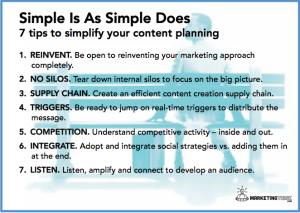A new year brings new opportunities to step up your email strategy. Columnist Jose Cebrian offers recommendations to help you reassess your email program and make it shine in 2016.

It’s a new year, and predictions abound. I’m not interested in passively waiting to see if they come true; I’d rather take the “make it happen” approach. That means taking stock of where we are, articulating where we want to be, then prioritizing the steps it will take to get there.
These are my suggestions for starting 2016 off with a plan to identify areas for improvement in your email strategy and then make those improvements happen.
Figure Out Why People Are Signing Up For Your Program
I don’t think enough companies really study this part of their program. The first place to look is at your signup pages, such as offline sources, online purchases, signup boxes, online banking registrations, mobile app downloads and so on, to ensure you understand what’s driving your customers to sign up.
Review the content to ensure that messaging is compelling and consistent, and then make sure you are delivering on the expectations you’ve set. And I don’t mean just the email program itself.
If a person signs up with the expectation of getting a special experience, for example, is it being delivered on across the site, email, customer service? If you’re not meeting expectations, this may be a driver of low engagement or high unsubscribes.
Test Your Email Program As If You’re A New User
Following on the above, you should experience your program as a new user. Sign up for email. Be sure to check out this experience from your phone, too. Is it easy to find the email signup? Is the lightbox unnecessarily annoying?
Look at the welcome email for grammatical errors, typos (You would be surprised at how many you find), old branding and so on. Time the welcome email. See what you get after that, and how often.
Are the messages on brand? Do they come quickly? Do they support the key message of your program?
What are the sending domains, from names, from addresses? Are they outdated, unfriendly, unbranded? I’m often surprised by emails from large, well-known companies that still utilize domains assigned by their email service provider (ESP).
Go to your opt-out page/preference center. Does it still look like it’s from 2005? It might need some updating.
Change a password. Buy something or register for something. See what you get, and from where. Open your emails from desktop and phone. Click on the links; see the web experience.
If there’s a problem for you, it’s likely a bigger issue that needs to be fixed quickly.
The biggest online challenge for many companies remains the mobile experience. If this isn’t a big priority for the marketing or e-commerce teams already, it needs to be.
Do a review of all your triggered and automated emails — you could have a lot of them. See what they look like and when they come. Are they still significant and relevant? Should they be updated? Deactivated?
Often, once an automated campaign is set up, it isn’t looked at again for a while. Emails should only be sent if they serve a particular purpose and should properly represent the company.
In your assessment, you may find that all is well. If so, you can feel good that the existing program is running the way you want, the customer experience is what people are signing up for, and the program is providing value for your customers.
If it’s not, then you need to prioritize which fixes are the most important from a brand and customer experience perspective. Part of that prioritization should be the scale of the problem.
In other words, do all email program participants have the same issue, or is it limited to only a few?
Look At Your Privacy Policy
As part of your email program review, you need to look at your privacy policy, if only as a refresher. But more importantly, you need to make sure that your email practices are in line with the policy — or at least don’t contradict them.
There are several new email-related technologies, and you want to make sure that you know which ones you can take advantage of.
Look at your statement about how you will manage email addresses, how email addresses can be shared, the use of site and IP address information. For example, if your privacy policy prohibits the sharing of your email address with “anyone, ever,” you may have an issue leveraging email addresses for addressable advertising such as Facebook Custom Audience, Google Customer Match and Twitter, or even an email address cleansing service.
My point here is not to prescribe, but rather to ensure that you address this aspect. Know what you’re working with and approach it intentionally. Your best bet is to discuss it with your legal counsel.
Work On Your Data Latency
Your data latency is the duration between when email data are created and when your email program can act on the data. Very few companies have real-time (or near-real-time) data working across their sites, stores/branches, ESP, DMP (data management platform) and so on.
In fact, the value of real-time data is often overstated, versus the effort required to get it. But that doesn’t mean timeliness is unimportant.
Some of your email programs surely rely on getting data quickly in order to be relevant. For example, it shouldn’t take four days to send an email that updates reward balances or a week to send a welcome message when you sign up for the program.
There may be pretty significant reasons why the latency occurs. One common reason is that data are coming from two or more completely different systems with infrequent feeds.
For example, data from a transactional system goes to the marketing database once weekly and must be aggregated before the values are available for the email program.
It may not be something you can fix quickly. But assess the situation, and determine if there are options (possibly new) that can help you minimize the lag.
Can you use services like Movable Ink to shortcut the data flow? Access it directly from the email versus moving the data between systems?
Look At Underlying Metrics
If you have a login-based service or e-commerce aspect to your program, you may have a large hidden problem. In a small personal survey of retailers’ results in 2015, we saw 24 percent average year-over-year growth in online revenue from email.
Some bigger companies may grow more slowly, but overall that sounds pretty good. It is.
But how do you make it bigger? Taking a few of the above actions will help.
Get serious about email address acquisition at site enter and exit, the retail counter and customer service.
One possible area for improvement is in the percentage of repeat buyers. If you want people to buy online repeatedly, you need to measure it and work on increasing it.
The desired outcome is greater share of wallet, higher revenues and higher direct profit from the customer base. So, to increase your repeat purchases:
• Make use of your data to engage users. Most people would suggest making your email program more engaging and relevant, which certainly helps, but it’s a significant endeavor that requires data and the ability to act on it.
• Ensure your program meets the expectations set out at signup. If not, you must resolve the discrepancy or risk alienation.
• Experience the entire buying experience from the site as a customer would. You may have an issue you don’t realize, such as poor packaging, unclear directions, confusing billing or inconvenient returns. These issues need to be fixed, as they are foundational.
• Talk to customer service. They are fielding calls, emails and tweets from customers. They may have some key nuggets of information straight from customers on where improvements could be made.
• Look at your competitors and distributors. Can customers get your product or information from them faster, cheaper, easier? If so, you need to reassess your value proposition.
Could you provide the newest models or information on your site first, if only for a little while? What can you offer to distinguish yourself from the competition?
• Incentivize the repeat purchase. One of my business school professors once said that “promotion is the brand manager’s drug.” His intention was to limit our use of it.
I agree to an extent, but to be competitive, you can’t always avoid it altogether. For example, if you’re not offering free shipping, and other companies are, you at least need to test promotional offers to understand the impact and create business cases for or against them.
Perhaps there is a special offer for repeat purchase after the first buy to get people into the cycle. The point is to test your options to understand their impact.
All of the above recommendations are like a New Year’s checkup to see how things are working and identify what needs to be improved, left alone or culled.
With all that we juggle in our day-to-day endeavors, sometimes we don’t do enough to reassess what we have and how we communicate to customers, which can impact our bottom line. Sure, all may be well — but what if it’s not?
I look at a lot of big email programs, and every time I go through this exercise with a client, I find issues that need to be fixed. You may, too.
Some opinions expressed in this article may be those of a guest author and not necessarily Marketing Land. Staff authors are listed here.
(Some images used under license from Shutterstock.com.)
Marketing Land – Internet Marketing News, Strategies & Tips
(50)
Report Post






